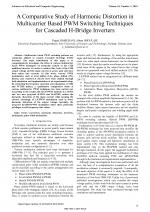| 3/2016 - 3 |
A Comparative Study of Harmonic Distortion in Multicarrier Based PWM Switching Techniques for Cascaded H-Bridge InvertersHAMEDANI, P. |
| Extra paper information in |
| Click to see author's profile in |
| Download PDF |
Author keywords
converters, harmonic distortion, inverters, modulation, pulse width modulation
References keywords
electronics(16), power(13), multilevel(12), transaction(10), industrial(9), inverter(8), inverters(7), modulation(6), cascaded(6), voltage(5)
Blue keywords are present in both the references section and the paper title.
About this article
Date of Publication: 2016-08-31
Volume 16, Issue 3, Year 2016, On page(s): 15 - 24
ISSN: 1582-7445, e-ISSN: 1844-7600
Digital Object Identifier: 10.4316/AECE.2016.03003
Web of Science Accession Number: 000384750000003
SCOPUS ID: 84991109323
Abstract
Multicarrier based PWM switching patterns are commonly utilized to control Cascaded H-bridge (CHB) inverters. The main contribution of this paper is to comprehensively investigate the effect of various multicarrier based PWM techniques on harmonic content of the CHB multilevel inverter. In order to achieve this, both of the CHB output voltage and the input current at power grid side have been taken into account. In this work, various PWM modulations such as level shifted (LS), phase shifted (PS), hybrid, and rotative-LS (R-LS) have been studied through both simulation and implementation of an experimental setup. By extracting the frequency spectrum and calculation of THD and WTHD indices, a quantitative comparative study of various multicarrier PWM techniques has been carried out. According to the results, the R-LS-PWM methods (i.e. R-PD, and two new proposed R-POD and R-APOD) reduce the harmonic distortion of the input current while keeping the obvious advantage of LS-PWM modulation such as lower harmonic distortion of the output voltage. Specially, the proposed R-APOD-PWM modulation offers these preferable privileges at odd frequency ratio values. |
| References | | | Cited By |
Web of Science® Times Cited: 7 [View]
View record in Web of Science® [View]
View Related Records® [View]
Updated 2 days, 6 hours ago
SCOPUS® Times Cited: 8
View record in SCOPUS® [Free preview]
View citations in SCOPUS® [Free preview]
[1] A New Carrier-Based Pulse Width Modulation Scheme with Reduced Output Voltage Total Harmonic Distortion for Multi-Level Inverters, Noroozi, Mohammadreza, Abrishamifar, Adib, Rezaierad, Gholamali, IETE Journal of Research, ISSN 0377-2063, Issue 6, Volume 68, 2022.
Digital Object Identifier: 10.1080/03772063.2020.1793693 [CrossRef]
[2] Reduction in Total Harmonic Distortion in Induction Motor Drives with High-Performance FPGA Controller, SUMAM, M. J., SHINY, G., Advances in Electrical and Computer Engineering, ISSN 1582-7445, Issue 1, Volume 22, 2022.
Digital Object Identifier: 10.4316/AECE.2022.01005 [CrossRef] [Full text]
[3] A Single Source Hybrid Nine-Level Multilevel Inverter with Extension Topology, SANTHOSH KUMAR, K. V., DHEEPANCHAKKRAVARTHY, A., Advances in Electrical and Computer Engineering, ISSN 1582-7445, Issue 2, Volume 23, 2023.
Digital Object Identifier: 10.4316/AECE.2023.02009 [CrossRef] [Full text]
[4] RETRACTED ARTICLE: A novel design and performance improvement of symmetric multilevel inverter with reduced switches using genetic algorithm, Ponraj, Ram Prakash, Sigamani, Titus, Soft Computing, ISSN 1432-7643, Issue 6, Volume 25, 2021.
Digital Object Identifier: 10.1007/s00500-020-05466-7 [CrossRef]
[5] 700 MHz–1.4 GHz and 30–70%, Frequency, and Duty-Cycle Locking Loop, Babazadeh, H., Esmaili, A., IETE Journal of Research, ISSN 0377-2063, Issue 11, Volume 70, 2024.
Digital Object Identifier: 10.1080/03772063.2024.2377763 [CrossRef]
[6] Investigation and validation of an eleven level symmetric modular multilevel inverter using grey wolf optimization and differential evolution control algorithm for solar PV applications, Stonier, Albert Alexander, Chinnaraj, Gnanavel, Kannan, Ramani, Mani, Geetha, Circuit World, ISSN 0305-6120, Issue 1, Volume 47, 2020.
Digital Object Identifier: 10.1108/CW-12-2019-0197 [CrossRef]
Disclaimer: All information displayed above was retrieved by using remote connections to respective databases. For the best user experience, we update all data by using background processes, and use caches in order to reduce the load on the servers we retrieve the information from. As we have no control on the availability of the database servers and sometimes the Internet connectivity may be affected, we do not guarantee the information is correct or complete. For the most accurate data, please always consult the database sites directly. Some external links require authentication or an institutional subscription.
Web of Science® is a registered trademark of Clarivate Analytics, Scopus® is a registered trademark of Elsevier B.V., other product names, company names, brand names, trademarks and logos are the property of their respective owners.
Faculty of Electrical Engineering and Computer Science
Stefan cel Mare University of Suceava, Romania
All rights reserved: Advances in Electrical and Computer Engineering is a registered trademark of the Stefan cel Mare University of Suceava. No part of this publication may be reproduced, stored in a retrieval system, photocopied, recorded or archived, without the written permission from the Editor. When authors submit their papers for publication, they agree that the copyright for their article be transferred to the Faculty of Electrical Engineering and Computer Science, Stefan cel Mare University of Suceava, Romania, if and only if the articles are accepted for publication. The copyright covers the exclusive rights to reproduce and distribute the article, including reprints and translations.
Permission for other use: The copyright owner's consent does not extend to copying for general distribution, for promotion, for creating new works, or for resale. Specific written permission must be obtained from the Editor for such copying. Direct linking to files hosted on this website is strictly prohibited.
Disclaimer: Whilst every effort is made by the publishers and editorial board to see that no inaccurate or misleading data, opinions or statements appear in this journal, they wish to make it clear that all information and opinions formulated in the articles, as well as linguistic accuracy, are the sole responsibility of the author.





